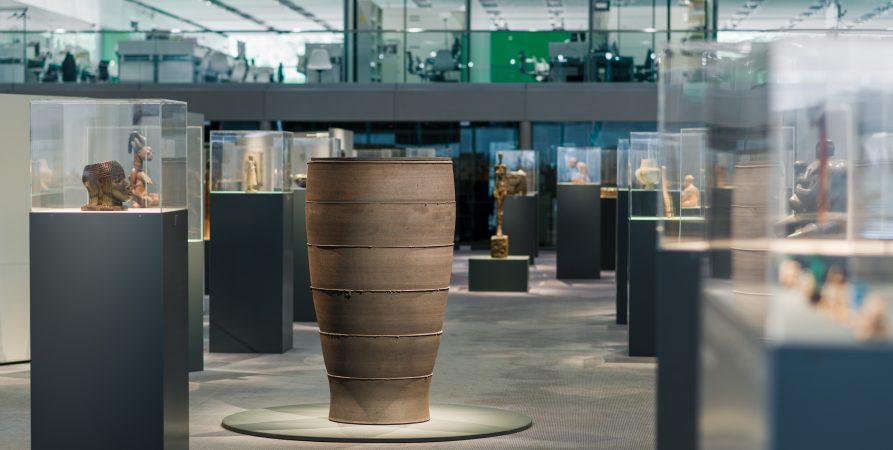Vase
Julian Stair
Life Story
This thrown porcelain vase is a prime example of Julian Stair’s investigation of the relationship between form and surface in pottery during the early 1980s. This and other similar examples in the Sainsbury Centre Collection (945, P.058, P.075) showcase the striking variety of effects that Stair was able to produce in very similar forms, through contrasting treatments of surface decoration.
Horizontal white bands circulate the body of the pot at regular intervals, intersecting narrower, vertical, hatched, incised lines of sgraffito decoration. These build a wonderful surface texture, as the regularity of the lines interrupt the general flowing curve of the vessel’s swollen form. In contrast to another vessel of a very similar form (945), the design used here produces less of a flowing movement, rather our attention is split between the different areas and forms of decoration.
In 1985 Stair exhibited this piece and vase 945 with Contemporary Applied Arts at the Chelsea Craft Fair, London, where Lady Sainsbury was one of the judges. He won second prize and Lady Sainsbury purchased both pieces for the Sainsbury Centre Collection. [1]
Stair describes the context of the field he was working in during the early 1980s:
‘Minimalist Art was one of the dominant strands and factors of contemporary practice at the time…and, ultimately, that attitude was something that made me dissatisfied with a way of working that…somehow had moved me away from the original reasons of which I was attracted to making pots… I was able to have a second chance in education and I went to grad school at the Royal College of Art…I sent myself back to the beginning again, a kind of self-imposed return to basics and I started to investigate ways of making pots…eventually I realised that the wheel was the most appropriate way…
…Fortunately I came across someone who turned out to have a huge impact on my practice whose name was Phillip Rawson…[who] bypassed all of the political debates, …small world in-fighting of ceramics…and wrote about pots in a global sense…it was a truly radical and visionary approach because he was looking at pots in a kind of transnational way and over history…and it was just such an interesting and uplifting way to think about these objects… I started to think about pots in the round and think about the relationship between form and surface which I think is a really fundamental part of pottery and something that is really unique. Pottery isn’t painted sculpture and it’s not paintings in the round…pottery occupies a very distinct physical space.’ [2]
Julian Stair is one of the UK’s leading ceramic artists, creating works of art on both a monumental and intimate scale. Stair has become a leading historian of English Studio Ceramics, completing a PhD at the Royal College of Art researching the critical origins of English Studio Pottery.
Katharine Malcolm, June 2020
[1] Cyril Frankel and James Austin, Modern Pots (Norwich: University of East Anglia, 2000), p.156.
[2] Interview with the artist, phone call 19/06/20
Further Reading
Frankel, Cyril, and James Austin, Modern Pots (Norwich: University of East Anglia, 2000)
Jones, Jeffrey, Studio Pottery In Britain 1900-2005 (London: A & C Black, 2007)
Watson, Oliver, Studio Pottery (London: Phaidon, in association with the Victoria and Albert Museum, 1993)
John M. Anderson Endowed Lecture Series: ‘A Sense of Place’, The Pennsylvania State University, 18 February 2014: https://www.youtube.com/watch?v=FTyzNba2KL4
Not on display
Title/Description: Vase
Artist/Maker: Julian Stair
Born: 1983 c.
Object Type: Vase
Materials: Porcelain
Technique: sgraffito, Throwing
Measurements: h. 137 x w. 89 x d. 89 mm
Accession Number: 936
Historic Period: 20th century
Production Place: Britain, England, Europe
School/Style: Studio Ceramics
Copyright: © Julian Stair
Potted History: Julian Stair and the Sainsbury Centre
From meeting Lisa Sainsbury in 1982, to his latest monumental jars, the artist discusses his history with the Centre
Continue reading






